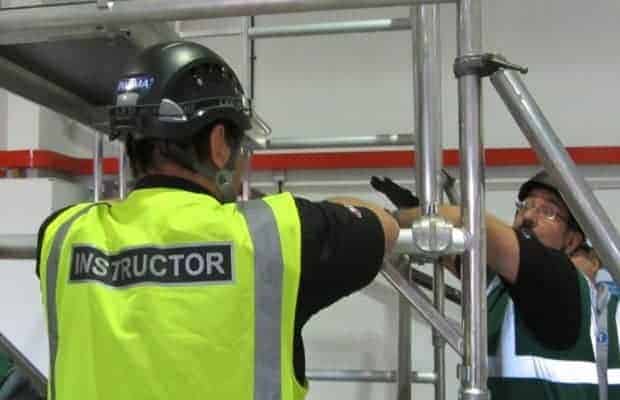Scaffolders unite for charity football match

Scaffolders from Hertel and Interserve will do battle on the pitch in a bid to raise money to help support the family of a Merseyside mum who tragically died of leukaemia.
33-year-old Claire Mandaluff passed away at home with her family after a four year battle with the disease, leaving partner Gavin O’ Hara to look after their two girls, Tillie, 8, and Florence, 1. Gavin’s colleagues from scaffold company Hertel, based at Stanlow, will join together with fellow scaffold workers from Interserve, based in Runcorn, for a charity football game to be played at the BA Flinders St on Saturday 25th January (kick off 11am). Organisers Anthony Godfrey and Darren McGill have also set up a night of entertainment afterwards, which will include raffles and auctions, at the Shakespeare public house in Williamson Square Liverpool city centre. All proceeds will go Claire’s family. News source: http://www.liverpoolecho.co.uk/news/liverpool-news/charity-football-match-raise-funds-6529565XERVON Palmers launches health & safety initiative
Scaffolding contractor XERVON Palmers, has launched an in-house health and safety initiative – the Safety Recognition Scheme (SRS) – aiming to maintain and encourage the improvement of standards in scaffolding access provision for users and customers, through the recognition of excellence in services.
The innovative XERVON Palmers scheme was launched in December 2013 and its key aim is to encourage all to maintain and improve a safe working environment, through recognising good health and safety practice at work – with a series of awards available to employees for delivering excellence in safe scaffolding and access working practices. Nominations for the SRS will be generated from one employee to another, and can include groups, as well as individuals. And the SRS monthly and quarterly awards include one extra day’s holiday with pay, plus a monthly/quarterly £100 charitable donation made by XERVON Palmers to the winners’ charity of choice. And the top SRS annual award is a weekend break in the UK for two (with the winner of the 2013 to be announced in January 2014). The introduction of the monthly, quarterly and annual Safety Recognition Scheme invites all XERVON Palmers staff members, direct employees, agency & part time workers to nominate a colleague for the safety recognition awards. A special SRS monthly ‘Recognition Panel’ (made up of a project manager, safety advisor and supervisor) judge which of the applicants is the winner each month, with each area or significant project having its own recognition panel. Then each monthly winner’s submission from the preceding three months will be considered by the Quarterly Recognition Scheme Panel (which will be made up of XERVON Palmers Managing Director and Company Operations Manager) to determine a quarterly winner. SRS award winners will be judged on proactive solutions and behaviours like sound safety observations, sensible interventions, making safety suggestions, reporting ‘close calls,’ being influential at safety meetings and other positive contributions when assisting safety inspections and tours. Winners of the monthly award will be announced the second Monday of the following month, with quarterly winners being announced Spring, Summer, Autumn and Winter, and the overall 2014 Annual SRS Award winner will be unveiled in January 2015, after consideration of all the monthly and quarterly winners and consultation between the XERVON Palmers Managing Director and Company Operations Manager. XERVON Palmers MD, Donald Morrison & Company Operations Manager, Andy O’Connor launched the new SRS program in December 2013 and awarded the first monthly – and 2013 annual – winner based on December monthly nominees. The inaugural winner was Mick Burrows – who won the annual accolade and a weekend away for his outstanding safety contribution on the Kingston Bridge Project. Ian McFarlane, Director for Business & Project Development at XERVON Palmers said:“Congratulations to Mick for being our first SRS 2013 Annual award winner. Whilst working on a night shift, XERVON Palmers and our key subcontractor Envirowrap were requested to work in two areas instead of the planned one. When Mick reviewed the works, he ascertained that the second work area had very poor lighting, plus there was an added danger of a live high voltage third line very close by, combined with the fact that there was only one Controller of Site Safety (COSS) available on site. So, Mick Burrows sensibly took it upon himself to act by stopping work and deciding to revert to the original plan of working in one area at a time. This meant the COSS and lighting could be concentrated in one area rather than depleted across two, meaning operations could carry on safely avoiding a potential accident. “This new reward-led initiative will help us continue to set the highest possible standards in health and safety in the scaffolding and access industry. It’s all part of a wider aim to maintain, improve and encourage our existing safety-focused, skilled working teams to ensure that the operations we provide for our clients are executed safely. “We encourage all to think and take time out to ensure they protect themselves, the public and those around them when they are at work – and when good behaviors such as Mick’s are observed we should reward and recognise those individuals who work with safety at the forefront of their mind.”Donald Morrison, CEO of XERVON Palmers added:
“We are a company that believes we can all make the difference, working as a team, hence our company slogan ‘Where the people make the difference’. The new SRS scheme is another tool to help us continue to create safer behaviours in our working environment; initiatives like this create win-win positions by raising standards in health and safety in our industry. “As ever this starts with our own efforts to collectively improve standards where we can in-house, this combined with the fact that the scheme helps improve motivation & boost staff morale and we are able to contribute to deserving charity causes are all added bonuses.”
Scaffolding fees to soar by 9% in Brighton and Hove
Local news has reported that Scaffolding fees are set to soar by 9% in the Brighton and Hove area.
The reports suggest that from April, Scaffolding firms wanting to erect jobs will have to pay £60 for the first six weeks the structure is there – an increase from £55 (9.1%). Companies will have to pay the same amount to keep it there for every eight weeks after following a similar rise. Despite a last minute bid from Conservative councillors to reduce the rise to an inflationary 2.5%, the plan was voted through by other elected members. The local authority said the increase was to bring it up to the same level of charging as neighbouring authorities. Conservative councillor Graham Cox said:“I think it is an unnecessary tax on the very people we should be encouraging to get on with construction, building and renewing our beautiful buildings.”In response, Green councillor Christopher Hawtree said:
“I’m not sure any business will collapse because they cannot afford an extra £3.50 for scaffolding.”
GKR Scaffolding announce the release of Elimin8 the next generation of scaffold fitting
GKR Scaffolding is proud to announce the release of the next generation of the safest fall prevention fitting fixings on the market, ‘Elimin8.
GKR Scaffolding and Loughton Scaffold Suppliers have joined forces to develop a revolutionary tethered scaffold fitting. The tethering point enables main scaffold fittings to be tethered until they are securely fixed. Neil Rowswell, GKR’s Managing Director who was involved in its development explains the benefits. Elimin8 has been designed, developed and tested by industry leaders GKR Scaffolding Ltd with support from Loughton Scaffold equipment suppliers. The revolutionary tethered scaffold fitting allows all the main scaffold fitting types to be securely tethered until fixed. Over the last few years GKR Scaffolding has worked on over half of London’s tallest building developments, including western Europe’s tallest tower. At GKR Safety is an embedded value where they constantly strive for ways to improve the safety of their employees, stakeholders and the general public. As part of GKR’s continuous drive to reduce risks in 2011, they introduced 100% tool tethering as a mandatory requirement to help reduce the risk of tools falling from height. The next steps for the GKR management team were to look for an innovative way to not only tether tools but to tether scaffold fittings. Neil Rowswell, Managing Director of GKR and member of the NASC Technical Board committee, led the working group who designed Elimin8 the simple safe system that allows the scaffold fittings to remain tethered until fixed. Neil commented:
“We [GKR Scaffolding] are proud to be known for our commitment to leading excellence in scaffolding and of our industry-leading safety performance. Since introducing the tool tethering policy we have had zero accidents involving tools falling from height. A natural progression for us was to see how we could tether all fittings for situations where they may be required. Elimin8 has been developed by real scaffolders who will be using it in all weather conditions, heights and working conditions. I am proud to be part of the team introducing Elimin8 to the scaffolding industry. Together we can help reduce risks and improve safety.”
The scaffold fitting range is now available and can be purchased through www.loughtonscaffolding.com www.gkrscaffolding.co.uk
Neil Rowswell, Managing Director of GKR and member of the NASC Technical Board committee, led the working group who designed Elimin8 the simple safe system that allows the scaffold fittings to remain tethered until fixed. Neil commented:
“We [GKR Scaffolding] are proud to be known for our commitment to leading excellence in scaffolding and of our industry-leading safety performance. Since introducing the tool tethering policy we have had zero accidents involving tools falling from height. A natural progression for us was to see how we could tether all fittings for situations where they may be required. Elimin8 has been developed by real scaffolders who will be using it in all weather conditions, heights and working conditions. I am proud to be part of the team introducing Elimin8 to the scaffolding industry. Together we can help reduce risks and improve safety.”
The scaffold fitting range is now available and can be purchased through www.loughtonscaffolding.com www.gkrscaffolding.co.uk Another record breaking year for PASMA training
In 2013 PASMA training centres were responsible for training over 65,000 people to work at height safely. The number, a new record for the mobile access tower association, is an increase of almost 10% from 2012’s figure.
This latest rise is in line with PASMA’s progress over recent years. At the beginning of this year there were around 320,000 active PASMA cards in circulation, the result of a series of steep increases over the past five years. PASMA training courses are now recognised as the industry standard. As a result, health and safety professionals increasingly specify the PASMA certificate of competence and photocard as the only acceptable proof of competence when using mobile access towers as required by the Work at Height Regulations (WAHR). The rise came during a year of significant growth for the association. During 2013 PASMA agreed a partnership with Scotland’s electrical trade association SELECT to make tower training more accessible to the electrical industry, expanded its presence overseas, launched PAS 250 – the first minimum standard specification for low level work platforms – and held the first national Tower Week. Sponsoring PAS 250 involved working with the British Standards Institution and consulting with organisations including the Health & Safety Executive, Hire Association Europe and the UK Contractors Group. Its launch completed a three step plan involving the release of a guidance DVD and the low level PASMA training course. PASMA’s growth is expected to continue over 2014, fuelled at home by the likes of the alliance with SELECT as well as through industry events, building on the success of Tower Week. The first PASMA training centres outside of the UK have already been launched in Dubai and South Africa and work to expand the association’s presence in these regions will continue in 2014. PASMA’s Director of Training, Stuart Hopkins, said:“As the fifth consecutive increase in training numbers, it demonstrates the importance that both managers and users attach to the benefits of PASMA training. Adding new safety-related training options and continuing our work as the voice of the tower industry will continue to promote this safety message in 2014.”
Cape Wins Outstanding HSE Performance Award In Abu Dhabi
Global industrial services firm Cape have today announced they have received an outstanding HSE Performance Award from Abu Dhabi Marine Operating Company (ADMA OPCO) for the year 2012 on all ADMA jobs.
Abu Dhabi Marine Operating Company, ADMA-OPCO in brief, is a major producer of oil and gas from the offshore areas of the Emirate of Abu Dhabi. The Company prides itself in being a pioneering petroleum organization in this part of the world, having completed over 45 years of oil and gas production. The award was received by Cape on 5th December 2013 from Mr. Ali R. Al-Jarwan, CEO, ADMA during “Sustaining HSE Excellence Workshop” organized by ADMA at Abu Dhabi. Hema Chandran, Operations Director for Cape, said:“Cape Abu Dhabi is delighted to receive this prestigious award from our long-standing partner ADMA for having contributed towards the outstanding HSE performance during the year 2012. This exceptional achievement is testament to our team’s commitment, dedication and attention to detail during the safety performance in recent years.”Tim Callahan, Divisional Managing Director, said:
“My congratulations to the Cape Abu Dhabi team for achieving this Partnership Excellence Award “Outstanding HSE Performance Award – 2012” from ADMA. We are very focused on both maintaining long term quality relationships with our clients and in delivering operational excellence via their projects and sites. Today’s award indicates that we are making progress in both of these areas
Innovations: The ScaffCorroClamp
Debuting within the halls of ScaffMag, we would like to introduce this simple little product to the masses.
The ScaffCorroClamp. This innovative clamp enables scaffolders to safely lift corrugated roofing sheets up to multi levels with relative ease. Fixing the clamp to the sheets is very simple with the use of a standard scaffold spanner. The ScaffCorroClamp can secure as many as 6 sheets at a time (Max 66 kilos).Safety & Access Issue Advice for Scaffolding Contractors (Asbestos)
Training firm Safety & Access have issued advice for Scaffolding Contractors for managing and working with asbestos.
Safety & Access have said: There has been some correspondence recently causing confusion on the matter of licensed contractor’s requirements and the need for a license to be obtained by the scaffold contractor where the scaffold framework forms part of any enclosure. This matter has been raised due to the wording in the recent Approved Code of Practice 143 from December 2013… Safety & Access have produced a brief guidance summary for scaffolding contractors that is available here > http://www.safetyaccess.co.uk/wp-content/uploads/2012/08/Advice-for-Scaffolding-Contractors-Asbestos.pdfTrainee Scaffolder Falls To Death At Sydney Construction Site










